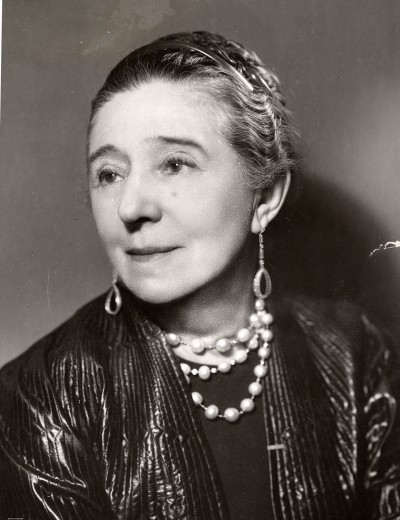
Jeanne Lanvin
About
the designers
Madame Jeanne Lanvin's active fashion career spanned 50 years from the 1890's up to the New Look just after World War II.
In 1867 Jeanne Lanvin was born in Brittany, France. She was the eldest of 10 children of a pair of Breton concierges. She first trained as a dressmaker at a house called Talbot and then as a milliner.
In 1890 she opened a millinery shop in the rue du Faubourg Saint-Honore. While making hats, she also made dresses for a younger sister and her daughter. Lanvin's clothes came to the attention of other mothers with daughters, who asked her to make dresses for them, so in 1909 Jeanne began making dresses for sale and her reputation grew.
She made no distinction between women's and children's wear, the youthfulness of both being an important aspect of 20th century fashion. Demand by young women for her clothes, persuaded Jeanne Lanvin to open a couture house selling mother-daughter garments.
Paul Iribe, the famous illustrator, created the Logo for the house of Lanvin, from a drawing by Jeanne of the bond between mother and daughter. Her daughter became the Comtesse de Polignac, and continued to wear her mother's beautiful gowns.
In 1913 Lanvin created her famous "robes de style" based on 18th century designs. These small waisted, full skirted dresses remained popular for many years and were fore-runners of the New Look which Dior brought out just after World War II.
In 1914 influenced by orientalism, she turned to exotic evening wear in Eastern-style velvets and satins.
During the 20's Lanvin made a simple Chemise dress which later became the basic outline for the twenties. Over the following years, she introduced several interesting developments. In 1921 a Riviera collection introduced Aztec embroidery. In 1922 a Breton suit appeared in the Lanvin collection. This comprised a gently gathered skirt, a short braided jacket with lots of small buttons and a big white organdie collar turning down over a red satin bow. A sailor hat topped the outfit.
In 1926 a menswear division was opened by Lanvin, and so she became the first couturier to dress whole families.
Her branches were opened in Nice, Cannes and Biarritz.
Jeanne Lanvin dressed film actresses like Mary Pickford, Marlene Dietrich and Yvonne Printemps in the 20's and 30's. She also had clients like the Queens of Italy and Roumania, and English princesses.
The house of Lanvin, like all other houses, suffered throughout the 2nd World War, although she kept designing.
In 1946, Jeanne Lanvin died at the age of 79. Her daughter Marie-Blanche took over the running of the house, till she herself died in 1958.
The Look
Her work was easily recognizable by her skilful use of embroidery, and her fine craftsmanship. She used a particular shade of blue so often, that it came to be called "Lanvin Blue". For Jeanne Lanvin, women were meant to wear clothes of unabashed feminity, in colours that were pretty, and whose shapes had a "young girl" look. She set the mood with narrow empire-wasted dresses and long trailing sleeves. The fabrics that she used were silk, taffeta, velvet, silk chiffon, organza, lace, tulle, etc. She used a lot of free-flowing ribbons, ruffles, flowers, lace, mirrors, etc., and liked ornamentation like applique, couching, quilting, parallel stitching, and embroidery.
Who Wears It
Natalie Portman